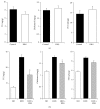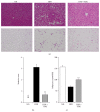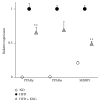Effect of keishibukuryogan on genetic and dietary obesity models
- PMID: 25793003
- PMCID: PMC4352422
- DOI: 10.1155/2015/801291
Effect of keishibukuryogan on genetic and dietary obesity models
Abstract
Obesity has been recognized as one of the most important risk factors for a variety of chronic diseases, such as diabetes, hypertension/cardiovascular diseases, steatosis/hepatitis, and cancer. Keishibukuryogan (KBG, Gui Zhi Fu Ling Wan in Chinese) is a traditional Chinese/Japanese (Kampo) medicine that has been known to improve blood circulation and is also known for its anti-inflammatory or scavenging effect. In this study, we evaluated the effect of KBG in two distinct rodent models of obesity driven by either a genetic (SHR/NDmcr-cp rat model) or dietary (high-fat diet-induced mouse obesity model) mechanism. Although there was no significant effect on the body composition in either the SHR rat or the DIO mouse models, KBG treatment significantly decreased the serum level of leptin and liver TG level in the DIO mouse, but not in the SHR rat model. Furthermore, a lower fat deposition in liver and a smaller size of adipocytes in white adipose tissue were observed in the DIO mice treated with KBG. Importantly, we further found downregulation of genes involved in lipid metabolism in the KBG-treated liver, along with decreased liver TG and cholesterol level. Our present data experimentally support in fact that KBG can be an attractive Kampo medicine to improve obese status through a regulation of systemic leptin level and/or lipid metabolism.
Figures






References
-
- Leung L., Kang J., Rayyan E., et al. Decreased basal chloride secretion and altered cystic fibrosis transmembrane conductance regulatory protein, Villin, GLUT5 protein expression in jejunum from leptin-deficient mice. Diabetes, Metabolic Syndrome and Obesity. 2014;7:321–330. doi: 10.2147/dmso.s63714. - DOI - PMC - PubMed
LinkOut - more resources
Full Text Sources
Other Literature Sources
Miscellaneous

